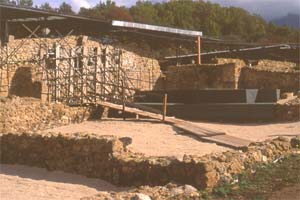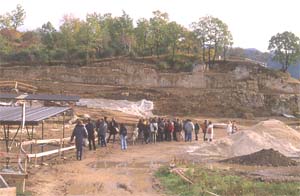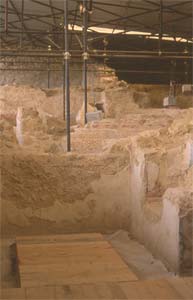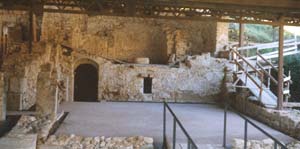 The
great abbeys
The
great abbeys
 The
Abbey of Montecassino
The
Abbey of Montecassino
 The
Abbey of St. Vincent al Volturno
The
Abbey of St. Vincent al Volturno
The
Chronicon Volturnense (history of the monastery written by Monaco
Giovanni in the 12th cent.) describes in great detail and with a
wealth of illuminations the vicissitudes of the Benevento noblemen and the
establishment of the monastic centre. The founding of the Benedictine abbey of
Saint Vincent dates back to the middle years of the 8th century.
Three Benevento aristocrats, Paldone, Tatone and Tasone, decided to settle in
the lands that they received as a gift from the Duke of Benevento, located
near a monastic nucleus founded by a small community of monks in 684. The
merit of improving the relations between the Volturno monastery and the court
of Charlemagne, from which he originated, must be attributed to Ambrogio
Autperto, Abbot around the year 777. Giosué was responsible for further
developments of the monastery and for a series of architectural works that
were to determine the functional arrangement of the monastic city until it was
destroyed by the Saracens in 881. He consolidated the relations with the
Carolingian court and reorganised the layout of the city, whose buildings
until then had risen in a haphazard fashion. Thanks to his efforts the
Volturno complex became one of the most important in Europe and played a
significant role in the control and management of a vast territory
characterised, in those days, by modest settlements and isolated castles (castella).
The architectural plan, as recent excavations show, displays innovative
characteristics. The model of the Constantinian basilica of Saint Peter’s in
Rome was substantially revised in some of its elements, with the elimination
of the transept and the addition of the ostwerk. The triapsidal
three-nave church had rows of sixteen columns on each side, and the material
recovered from Roman buildings was utilised in its construction. The crypt has
a semicircular elongated outer ring associated with an inner space in the
shape of the Latin cross. The geometrical patterns of the frescoes are heavy,
to create the illusion of a sepulchre full of diamonds, polychrome marbles and
multicoloured marquetry, a real subterranean paradise. The large refectory
could accommodate approximately 400 monks. The entire floor of the refectory
and of the other connecting halls consisted of terra cotta elements made in
the monastery. Its workshops produced silver, ivory, glass enamel and bronze (bell
foundries), but specialised in the production of the glass needed for the
large windows and small objects. The crypt of Epifanio, abbot from 824 to 842,
is frescoed with images that draw inspiration from the Apocalypse of Saint
John. In 881 the monastery was attacked by a group of Saracens. Only a few
decades later the monks managed to reconstruct the buildings, workshops and
churches, and to return the abbey to its former splendour.
 |
 |
 |
 |



![]() The
great abbeys
The
great abbeys![]() The
Abbey of Montecassino
The
Abbey of Montecassino![]() The
Abbey of St. Vincent al Volturno
The
Abbey of St. Vincent al Volturno


